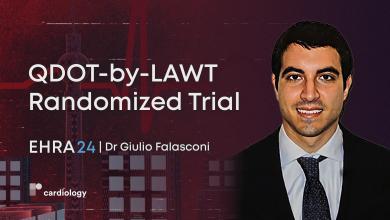Search results
RIO 2022 – Full Programme: On-Demand
Video Series
Author(s):
Tina Baykaner
,
Junaid Zaman
,
Paul J Wang
,
et al
Added:
3 years ago
Treatment of atrial fibrillation (AF) classically focuses on eliminating triggers near and from the pulmonary veins, which may initiate AF. However, the 1–2 year success rate of pulmonary vein isolation (PVI) remains 40–50% for persistent AF1,2 and 50–65% for paroxysmal AF,3–5 while supplementary linear lesions or extensive ablation at electrogram-targets have had disappointing results and may…
View more
Author(s):
Marius Andronache
,
Nikola Drca
,
Graziana Viola
Added:
3 years ago
AF is the most common sustained cardiac arrhythmia in clinical practice. It is associated with increased risk of stroke and heart failure (HF), and is a significant global health challenge.1 Catheter ablation procedures, which isolate the pulmonary veins (PV) from the left atrium and prevent AF initiation, are effective and safe treatment options, and have emerged as the preferred rhythm control…
View more
Author(s):
Giky Karwiky
,
Mohammad Iqbal
,
Raymond Pranata
Added:
4 months ago
In this episode of the Radcliffe Podcast, we are joined by Dr Raymond Pranata, Dr Mohammad Iqbal and Dr Giky Karwiky (Hasan Sadikin General Hospital, Bandung, Indonesia) as they discuss their recently published systematic review and meta-analysis of very-high-power short-duration ablation as compared to conventional ablation for the treatment of pulmonary vein isolation in atrial fibrillation.13…
View more
Added:
6 years ago
Author(s):
Dimitrios Vrachatis
,
Spyridon Deftereos
,
Vasileios Kekeris
,
et al
Added:
3 years ago
Heart failure (HF) and AF share common pathophysiologic pathways and often coexist.1 Indeed, HF has been identified as the strongest predictor of AF in a Framingham Heart study population-based cohort.2 Moreover, HF and AF are involved in a vicious pathophysiological interplay. HF promotes AF mainly through raised atrial filling pressures, abnormal calcium handling, neurohormonal activation and…
View more
Added:
6 years ago
Author(s):
Dipen Shah
Added:
3 years ago
Atrial fibrillation (AF) is the most common sustained cardiac arrhythmia, is associated with increased risk of stroke and heart failure and is a significant global health challenge.1 Pharmacological treatments to restore sinus rhythm in patients with AF are associated with a considerable relapse rate,2,3 whereas nonpharmacological interventions, such as catheter ablation procedures, which isolate…
View more
Author(s):
Giulio Falasconi
Added:
2 days ago
EHRA 24 - In this video, investigator, Dr Giulio Falasconi (Humanitas Research Hospital, IT) joins us to discuss the findings from the QDOT-by-LAWT trial. This study included 162 patients with paroxysmal atrial fibrillation not responding to antiarrhythmic drugs. They were retrospectively enrolled and randomized on a 1:1 basis to the QDOT-by-LAWT study group, and the control group.Findings showed…
View more
Author(s):
Satoshi Higa
,
Li-Wei Lo
,
Shih-Ann Chen
Added:
3 years ago
Catheter ablation of AF has become an established therapy and may have the potential to cure this most commonly encountered sustained arrhythmia. Previous studies have demonstrated that pulmonary veins (PVs) are a major source of the ectopic beats that initiate AF. PV isolation in patients with symptomatic paroxysmal AF refractory to antiarrhythmic drugs is effective; however, it is difficult to…
View more
















 « First
« First